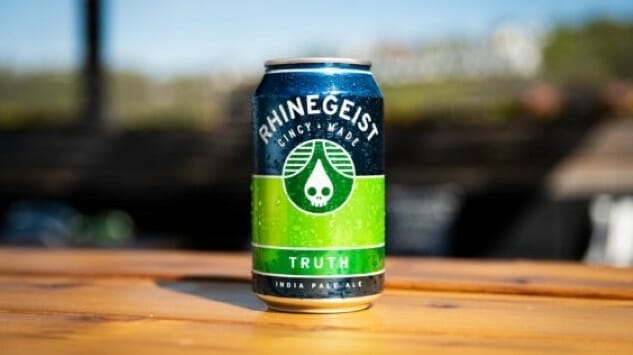My Month of Flagships: Rhinegeist Brewery Truth IPA
Photos via Rhinegeist Brewery Drink Features craft beer
This essay is part of a series this month, coinciding with the concept of Flagship February, wherein we intend to revisit the flagship beers of regional craft breweries, reflect on their influence within the beer scene, and assess how those beers fit into the modern beer world. Click here to see all the other entries in the series.
The very nature of this series, which is focused on regional and national flagship beers, tends to imply breweries that have been around for a while. The 2010s, characterized first by rabid growth and then eventually by the slowdown of the craft beer market, showed that very few breweries founded in the past decade will ever likely have the chance to grow to powerful regional or national status, for a variety of reasons—the styles they focus on don’t scale well to mass production, there’s just too much competition, and the regional kingpins are dug in as deeply as they can in their trenches. In fact, of the top 50 craft brewers (via the Brewers Association definition), the most recently available data includes only 3 that were founded in the 2010s: Modern Times Beer, Revolution Brewing (whose Anti-Hero IPA we covered already), and Rhinegeist Brewery.
And the biggest of all of them, by a sizable margin? Cincinnati’s Rhinegeist, which is all the more incredible when you consider that they were actually founded in 2013. This hip Cincy brewery has done something that not a single other company of its generation could manage, now finding itself in the top 30 of the biggest craft breweries by volume. That’s truly unique, and the lion’s share of that growth is thanks to its astoundingly successful flagship IPA, Truth.
It’s no surprise, then, that Rhinegeist is passionate about its flagship—like, really passionate, as the pamphlet I received a few months ago detailing the full history of this particular beer would indicate. Truth has been the key to the sort of meteoric rise across multiple states that almost doesn’t happen anymore in the beer industry, fueling growth numbers that are only more crazy when you look at them in more depth. Consider the fact that in 2014, Rhinegeist was producing just over 10,000 barrels. They quintupled that number within five years, brewing more than 100,000 barrels in 2018. Ask any other brewery owner who started his business in the last decade, and he’ll tell you how impressive those numbers are.
So what is it about Truth, then, that made first Cincy and then all of Ohio and beyond (Rhinegeist is still only in six states) take notice? To look at the recipe, it looks pretty familiar—light malt bill with a little bit of structure, supported by some popular players on the hop front: Amarillo, Citra, Simcoe, Centennial. Was it impeccable balance that built this phenomenon? Or savvy marketing? Or the most likely combination of the two?
Truth actually isn’t a beer I’ve had often in the past, so the only way I’ll be able to make an educated guess is by giving it a taste.
Tasting: Rhinegeist Truth IPA
First, here’s how the brewery describes their flagship:
Rare are moments of truth, when you’ve struck the last match, belting out tunes with your friends, staring deep into the campfire – times when you feel infinite. Our Truth is found in the scintillating brilliance of hops. Brewed with a nod to the Pacific, hops sizzle with tropical fruit aroma, grapefruit and mango notes and a dry finish.
I can’t speak to whether this beer might aid in any out-of-body “staring deep into the campfire” experiences, but Rhinegeist’s flavor profile description seems pretty spot on. Truth bridges a few different eras of IPA brewing, having arrived just before the hazy-juicy movement got into full swing, which is probably to its benefit.
On the nose, I get a light honey malt sweetness, which is brushed aside by a big wave of fresh green hops (like sticking your nose in a bag of hop pellets), resin and grapefruit zest. It suggests an IPA that is primarily a hop showcase, but with at least a slight concession to malt. Note: As the beer warms, a more candied orange note emerges on the nose.
This is confirmed on the palate, where you can certainly detect some biscuity malt, with flashes of honey, which segues into big notes of grapefruit juice, mango and sticky resin. Slight residual sweetness amps up the citrus notes a bit, but it finishes plenty dry, with medium bitterness that builds as you take repeated sips. That bitterness level is right in the middle of the pack in terms of both the style and the other IPAs I’ve been tasting in this series, and that sort of judiciousness sort of sums up Truth as a whole. It’s fruit-forward without being very explicitly “juicy,” as would arrive in the genre a few years after it was introduced. It’s bitter without being a palate bruiser. It retains a modicum of malt balance, but hops are still the engine that drive the beer. It deals more in balance than it does in extremes, at least to a beer writer’s palate in 2020.
And in the end, it seems that’s how you build a brand that deals not just in hype, but in volume—the kind of beer that takes a brewery from not existing, to being the 28th largest craft brewer in the country just a few years later. You can say one thing for sure: A lot of breweries would kill to have a beer like Truth. But this flagship is an exception, rather than the rule.
Jim Vorel is a Paste staff writer and resident craft beer geek. You can follow him on Twitter for much more drinks writing.